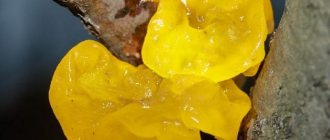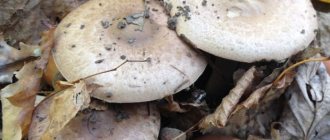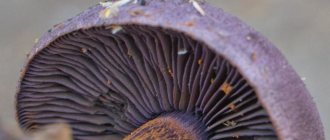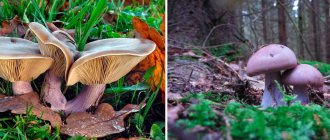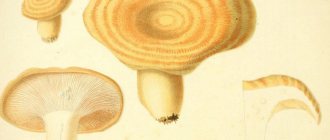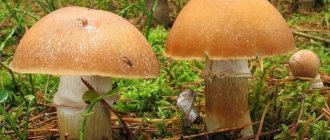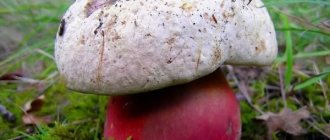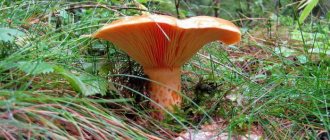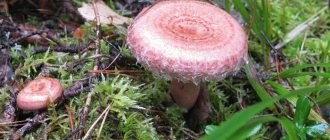Blueleg is a common exotic mushroom that scares off many mushroom lovers with its color. Grows in groups in visible places. Mushroom growers value bluelegs for its excellent taste. They say that fried podotavniki taste like meat. Due to its dense structure, the blue leg practically does not shrink after cooking.
Description, characteristics and category of mushroom
Bluefoot (scientific name Lepista saeva Lepista personata) belongs to the Ryadovkov family from the genus Lepista.
It can also be called: Potatavnik, Lilac-footed row, Goose row, Lilac-legged row, Blue-legged, Sinyushka, Two-color row, Blue root. Many people look at the blue leg with disbelief. Due to its unusual color, it is often considered poisonous and passed by. Like any other mushroom, the lilac-legged row has false doubles.
You can recognize the edible boletus mushroom by the following characteristics:
- The cap reaches a diameter of 6-10 cm and has a flat-convex shape. You can find a giant mushroom with a diameter of 25 cm.
- The top of the cap is smooth with yellowness and a slight purple tint. Inside this part the color is the same.
- The structure of young mushrooms is dense, and as they mature, it becomes looser.
- The hymenophore (lower part of the cap) consists of rare cream-colored plates.
- Spores are 7x5 µm, almost round, folded, veined, amyloid.
- The leg grows up to 10 cm. The base is slightly thickened. The leg is smooth with a blue tint.
- The smell of the row is not like a typical mushroom one. There is a sweetish aroma with fruity notes.
In Russia, the cost of rowing ranges from 150 to 300 rubles per kilogram. Pickled mushrooms in a three-liter jar cost from 1,500 rubles.
Contraindications
It is easy to confuse an edible mushroom with a false one in appearance, although the latter are bitter, caustic and toxic.
Once ingested, there is a high risk of damage to the gastric and intestinal mucosa. This may cause nausea and vomiting. Therefore, they can be distinguished at least by their bitter taste.
Edible bruise is contraindicated in the following cases:
- for heart diseases;
- the presence of stomach and duodenal ulcers;
- children under 12 years of age;
- period of pregnancy and lactation.
Excessive consumption of russula is prohibited even for people who do not have health problems. The maximum dose per day is no more than 150 g.
Collection time and place
Ryadovka is found in temperate climate zones in the autumn season. Habitats must have fertile soil with humus.
It can be:
- compost pit in the garden;
- peat bog;
- meadow spaces with chernozem soil;
- a forest hollow with an accumulation of rotten leaves.
Mushroom pickers will not have to wait a certain period to collect bluelegs. Podatavniki grow from April to the end of October.
They tolerate temperatures down to -5 degrees Celsius. Mushrooms grow in families in the form of a circle.
If you come across large specimens, it’s easy to go and collect more than 15 kg of mushrooms from one clearing.
The lilac-legged rower can be found in Ukraine, Russia and Kazakhstan. In Ukraine, it is better to go mushroom hunting in the Carpathian region. This is a real paradise for mushroom pickers. Beech and coniferous trees grow near the Beskid mountain ranges in the Skole Beskydy Nature Reserve. About 60 varieties of mushrooms can be found here. Among them there is an abundance of blue-legged row.
Another mushroom place is the village of Mokhnach in the Kharkov region. People go here to collect forest gifts from all nearby villages.
In Kazakhstan, rows are considered a delicacy. Their price can start from 700 tenge per kilogram, so many people prefer to look for and collect them rather than buy them. The favorite place of blue legs is southern Kazakhstan. The mushroom can be found anywhere in Russia. The most fertile places are central Russia and the Rostov region with many deciduous and coniferous forests.
When collecting lilac-legged row, you need to consider a number of tips:
- go hunting in sunny weather, because after rain the caps become covered with mucus and are not very pleasant to the touch;
- you can find large mushroom families in open, light meadows;
- You should not try raw row, as it belongs to the conditionally edible group.
It is better to immediately peel, boil and freeze the collected mushrooms, as they are stored for less than a day (in the refrigerator for up to 2 days).
Video
Methods for preparing bluelegs
After collecting and transporting blue stem mushrooms, they need to be processed as quickly as possible. They need to be kept in salt water for some time to eliminate insects that may be in the mushrooms. Bluelegs should be cleaned first.
Then they need to be washed under running water, boiled for 15 minutes, and drained. After this, they can be used to prepare various dishes.
Pickled bluelegs
Bluelegs are often pickled. Mushrooms prepared in this way are truly a delicious product, as they have an unusual, pleasant taste.
To prepare pickled bluelegs, you need:
- Boil peeled mushrooms (1 kg) for 20 minutes.
- Place in a colander and wait until the water has completely drained from the mushrooms.
- Pour a liter of water over the blue legs, put on the fire, and bring to a boil.
- When the water boils, add 2 tablespoons of coarse salt, a few bay leaves, and 12 black peppercorns. Also, if available, you can add a few oak or currant leaves - they will add a special taste and aroma to the finished product.
- Boil mushrooms with spices for 10 minutes over low heat.
- Take 2 cloves of garlic, chop, add to the mushrooms along with two tablespoons of vinegar.
- Boil everything together for 7-10 minutes.
Pour the mushrooms and brine into sterilized jars, close, and place in a warm place until cool.
You can also prepare dishes from bluelegs for a full lunch or dinner - first course, second course, salads.
Bluefoot soup
To prepare the soup, you need to take 500 g of mushrooms, one chicken fillet, 3 potatoes and 2 onions, medium-sized carrots, one bell pepper. You will also need salt, ground black pepper, and bay leaf.
Bluelegs soup is prepared as follows:
- The mushrooms are cleaned, washed, and boiled in salted water for half an hour.
- The fillet is cut into small cubes.
- Vegetables are peeled and cut: onions into small cubes, potatoes into cubes, peppers into thin strips.
- Grate carrots.
- Fry the onion in oil until transparent, then add carrots to it and bring until golden brown.
- The liquid in which they were boiled is drained from the bluelegs and filled with new water, chicken and potatoes are added, and put on fire.
- Boil the soup for 20 minutes. Add fried vegetables and peppers 10 minutes before the end.
- Add salt and pepper, cook for a couple more minutes and turn off the heat.
This mushroom soup is especially good with sour cream and finely chopped herbs.
Mushrooms in batter
These unusual mushrooms also make a good tasty snack - bluelegs in batter. They are suitable for both a family dinner and a holiday table.
For this recipe you will need: kefir (0.5 l), flour (500 g), bluelegs (1 kg) and vegetable oil.
- Mushrooms need to be cleaned, washed, and separated from the stems.
- Next you need to prepare the batter. To do this, mix kefir with flour, mix well so that the mass becomes homogeneous, without lumps. Leave the batter for 10 minutes.
- Heat vegetable oil in a frying pan. Dip the bluelegs caps into the batter, making sure that it evenly covers them on all sides, then place them in oil and fry on both sides until golden brown.
You can eat mushrooms in batter both hot and cold. Fresh dill and parsley are ideal for them.
Bluefoot, or purple-legged rower, is a mushroom common in spacious meadows and in places where areas are enriched with humus. Although it is considered a conditionally edible mushroom, it can be eaten without fear after heat treatment. Bluelegs can be grown in your garden plot or in special premises.
0
0
Copy link
Growing at home and in the country
Rowing can be grown at home and in open ground. The first harvest appears approximately 1.5 years after planting. In the future, you can harvest several times a year.
Growing bluelegs in the garden
To cultivate the plant in your dacha, you need to create a comfortable environment. To do this, you need to prepare compost and leave it for about 30-40 days. You need to mix 12 kg of rotten straw with 8 kg of organic fertilizer (bird droppings, cow or horse manure).
Mushrooms can be planted in spring or autumn at temperatures not lower than +15°C. To do this, spread the compost on the beds and place it in a box or bag. After planting, you need to regularly moisten the soil with water and mycelium.
After about 2-3 weeks, purple areas will appear. They need to be sprinkled with damp soil to a depth of 5 cm, without covering the crop. Mycelium will appear on the soil within 2-3 weeks. It remains to maintain the optimal humidity level.
The lilac-legged rower tolerates winter well. When the temperature drops below +5°C, the beds need to be covered with bags, and a layer of leaves or straw 10 cm thick should be laid on top. In the spring, the bags can be removed when the temperature warms up to +10°C.
Growing bluelegs indoors
This type of mushroom can be grown indoors. The main conditions for a successful harvest are optimal humidity, temperature +10-15°C, good lighting and ventilation. If the mushrooms get little light, they dry out and die.
Where does the meadow lilac-footed row (two-color) grow?
[includeme file=”wp-content/plugins/include-me/goog-left.php”]
Very tasty and popular among mushroom pickers is the meadow lilac-legged row. Its name speaks for itself, because it grows in pastures and meadows. In its taste and properties, this fruiting body is similar to champignons. In the marinade, the row takes on a snow-white appearance and amazing taste. However, experts believe that meadow row and lilac-legged are the same type of mushroom.
Where does the lilac-legged row grow and what places does it prefer to grow? Here everything will depend on soil and climatic conditions. Rows grow in all kinds of soils, and if the weather is favorable, then the harvest of these fruiting bodies will be large. In addition, the lilac-legged rower can be found in urban forest parks and in private plots. The mushroom is unpretentious, it would be warm and humid. It can often be seen in coniferous forests and forest plantations, where sandy soil predominates. They also prefer semi-sandy and humus soils. They even grow on fallen pine needles and rotted leaves.
The two-color row is widespread in the temperate zone of the Northern Hemisphere, in Kazakhstan, the Black Sea region and in the European part of the Russian Federation. But we must not forget that even edible types of grass, which are collected within the city or near industrial enterprises, are much more toxic than their meadow and forest counterparts. Very often, such mushrooms cause poisoning.
When to collect purple-footed row, so that it is not overgrown and retains all its beneficial vitamins and properties? I would like to say that these fruiting bodies, especially those growing in the southern regions of the country, can produce 2 harvests per year. The first appears in the spring and lasts until the beginning of autumn, and the second begins at the end of summer and continues until the first frost, that is, almost until the month of November. Under favorable weather conditions and with proper cutting of the row, mushroom pickers can collect these fruiting bodies in the same place for several years. Experienced mushroom pickers, knowing the places and timing of fruiting of the bicolor row, can collect from 100 to 150 kg of these mushrooms per season. Mushroom pickers love to collect it due to its dense pulp and resistance to transportation. Even after collecting the row in bags, you don’t have to worry: until you bring it home, it won’t break.
The proposed photos and descriptions of the blue-legged row will not allow inexperienced mushroom pickers to confuse this mushroom with another inedible species.
The fruiting bodies are resistant to cold, so they can be found even in late autumn and even in December. But other types of mushrooms do not have this ability, except for winter mushrooms.
False doubles
The purple-legged rower can be confused with the Purple and Weedy row, Goat's web and White-purple web. To bring home edible forest gifts, it is enough to know what an edible mushroom and its false doubles look like.
| Name of the mushroom | Description |
| Row purple | Purple or blue color of legs and caps |
| Weed row | Less lilac-legged, with a thin stalk |
| Goat's web | Massive mushroom with an unpleasant odor |
| Purple web spider | A hat with an ash tint, and a “skirt” underneath it |
| White and purple web spider | Specific smell; when broken, the pulp is light yellow with purple spots |
Edible or not
Unfortunately, its attractive and at the same time intimidating appearance scares off most novice mushroom pickers due to concerns about edibility. Some even manage to push the family with their feet so as not to germinate next to the noble breeds. However, despite its underestimation, the lilac-legged or blue-footed row remains an edible mushroom with valuable nutritional properties that can replenish the daily requirement of an adult. Experienced lovers of quiet hunting quite often replace meat with their pulp, creating a varied daily diet during periods of dietary nutrition and Orthodox fasting.
The fourth category of edibility involves heat treatment, which consists of repeated boiling and draining of the broth.
Important!
Don’t be alarmed if the mushrooms change their color during cooking; this is a common feature.
Evaluation of taste qualities, medicinal properties, benefits and possible harm
Bluefish have excellent taste. Their flesh resembles chicken meat and is similar to young champignons. It has antibacterial, antioxidant, antiviral, anti-inflammatory and immunomodulatory properties.
Advantages of rowing:
- has a beneficial effect on the cardiovascular system;
- relieves chronic fatigue and headaches;
- normalizes blood sugar levels;
- increases physical and mental activity;
- normalizes the functioning of the gastrointestinal tract;
- removes waste and toxins;
- strengthens the immune system.
In folk medicine, bluelegs is used to make antibiotics and anti-inflammatory drugs.
An extract is created from the mycelium that reduces the activity of cancer cells. Infusion and lilac-legged rower are used to prepare various ointments for the treatment of skin diseases.
Doctors recommend consuming mushrooms for nervous disorders and diabetes. Rowing is useful for people suffering from diseases of the liver and genitourinary system.
Another area of application of the mushroom is cosmetology. The dried row is ground into powder and a facial lotion is created on its basis. The product is recommended for people with increased secretion of subcutaneous fat, irritation and acne.
Eating raw bluefish can cause serious problems.
Overgrown mushrooms absorb various harmful substances: copper, mercury, cadmium, pesticides. Eating such mushrooms leads to flatulence, pain and heaviness in the stomach.
It is not recommended to eat a lot of botanicals with low acidity. Serious contraindications are: pancreatitis, cholecystitis, chronic gastrointestinal diseases and gallbladder dysfunction.
Composition and calorie content
This variety of mushrooms has a varied composition:
- minerals - calcium, phosphorus, potassium, selenium, sodium, zinc, manganese, iron, copper;
- vitamins - group of vitamins B, betaine, choline, ascorbic acid, vitamins A and D;
- natural antibiotics - clitocin and fomecin;
- polysaccharides;
- amino acids - there are 18 amino acids in the rows (the highest concentration of lysine, threonine, alanine, phenylalanine, glutamic, aspartic and stearic acid);
- phenol is an antiseptic substance.
100 grams of bluelegs contain 2.4 g of protein, 1.8 g of carbohydrates and 0.83 g of fat. Calorie content is only 20.2 kcal per 100 g. The optimal combination of biofuel and low calorie content makes mushrooms attractive to people who adhere to a healthy diet.
Comments (8)
Anya
03/27/2019 at 06:00 |
In general, all mushrooms are very difficult on the stomach, so I would not say that this only applies to this mushroom. But the fact that it will take a long time to grow is not very good. How to speed up the process?Answer
Yulia Expert Plodogorod
03/27/2019 at 23:48 |
Hello, Anya! In order for mushrooms to grow faster and produce a good harvest, you need to follow the growing rules. In addition, there are activators or growth stimulants. They must be used with caution and after carefully studying the composition. After all, mushrooms, like sponges, can absorb various substances.
As for the rules for cultivating the blue root, first, you need to purchase high-quality planting material, that is, mycelium. You can use the remains of collected or purchased mushrooms, or purchase a package of mycelium.
It is important to loosen the soil well before planting. After the mycelium is in the soil, it needs to be sprinkled with loose soil on top. Before this, the material for sprinkling is mixed with humus in a one to one ratio.
It is better to organize mushroom beds under trees or bushes. Any type of plant will do. Regular watering is important, especially in dry weather.
If you want to grow these mushrooms indoors, then the technique is the same as for other types, for example, champignons. We only recommend planting some perennial grass. It should be noted that such mushrooms grow better in open ground, although growing indoors is also quite possible.
Answer
Yana
04/08/2019 at 07:39 |
It seems to me that growth stimulants and activators are not always the best solution. Will people be allergic to them? Although I know that they are often added to mushrooms, somehow we all grow “oyster mushrooms”.
Answer
Yulia Expert Plodogorod
04/09/2019 at 01:02 |
Hello, Yana! Typically, such products are used for industrial cultivation. We do not recommend using growth or productivity stimulants without experience and knowledge. Or, at least, without consulting a specialist.
If you use such products incorrectly, it will actually harm both the plant or mushroom and the person who will consume the crop.
Typically, these drugs can accelerate growth and increase yield by no more than 15 percent. Other factors are also important, such as temperature, humidity, in some cases light, and how nutritious the soil is. This means that the stimulant can only help in cultivation, but not replace the required conditions.
There are stimulants of natural origin. Horse and cattle manure, as well as chicken manure, are considered the most powerful.
As for synthetic ones, it is important to observe the measure not only to avoid harmful effects on the health of the fruit consumer. An excess of the stimulant will inhibit the plant or fungus to which the drug was applied.
It is advisable to use such means if the grown specimens have experienced some kind of shock or cataclysm, for example, they have withered or dried out due to lack of moisture. You can also try to restore a crop damaged by disease or pests.
One of the disadvantages is that some plants simply die after some time after intensive treatment. This happens especially often if they were prepared as seedlings or simply for sale. The same can be said about the processed mycelium.
If you decide to use such drugs, we recommend that you pay attention to the hazard class. This is a more reliable source of information than a label saying that the product is harmless to humans, mushrooms and plants.
Some experts express the opinion that such substances are best used only for ornamental crops and mushrooms that are not used for food.
Answer
Olya
05/19/2019 at 01:19 |
I have great difficulty imagining how to fertilize mushrooms with cow manure if they are grown in a small basement specially created for this purpose. After all, manure will stink very much!
Yulia Expert Plodogorod
05/19/2019 at 16:08 |
Hello, Olya! First of all, such a room must have ventilation. After all, even if you do not use organic fertilizers, a musty, unpleasant odor and stuffiness will very quickly form in such a place, which will have a bad effect on the crop being grown.
Further, it is believed that the beneficial properties of these fertilizers outweigh some of the discomfort of their use. Moreover, there are products that can be added to such a mixture to neutralize the unpleasant aroma. This may be silica in powder form.
Both dung and mullein are used not in concentrated form, but most often in the form of a solution, and in a fairly weak concentration. This, accordingly, significantly reduces the discomfort during use.
And finally, if we are talking about specifically humus, that is, rotted manure, then it should not have any odor at all if the substance is completely fermented and ready for use.
If you are so concerned about the possibility of a strong odor from organic fertilizers, you can use synthetic substances. They are generally odorless and there is no shortage of them and can be purchased at most gardening stores.
Oksana
06/08/2019 at 00:16 |
I've never heard of such a mushroom. In our country it would most likely be classified as poisonous. Although it is considered conditionally edible, I would not try it, I was afraid. I rarely eat mushrooms, I have enough champignons and sometimes I can buy white ones at the market.
Answer
Yulia Expert Plodogorod
06/08/2019 at 16:54 |
Hello, Oksana! The biggest concern is that there are a number of other mushrooms that are very similar to Blue Root. And they, unlike the described mushrooms, cannot be eaten. Therefore, if you do not have experience in collecting and preparing such products, then it is better to really limit yourself to safe and proven purchased options.
We would like to note that Bluelegs row can be used in cooking and contains a lot of vitamins and beneficial microelements. According to reviews, the taste is reminiscent of champignons.
But, if you prepare such mushrooms incorrectly, or eat too much, stomach problems will occur. In addition, such foods are slowly digested and poorly absorbed. Therefore, we recommend paying attention to the general condition and weighing the consequences before use.
Dishes containing such products are not recommended for people with gastrointestinal diseases. They are not suitable for children and pregnant women. In the described category, after consumption, symptoms of poisoning may be observed, including vomiting and hallucinations. It's safer to eat only hats.
This type of mushroom is often used in medicine. The extract from the described fungus is used for the production of biologically active additives. Sometimes Blue root is used in cosmetology, but also in processed form.
When consuming any mushrooms, we recommend exercising moderation and caution. As has been correctly noted, it is better to use those species that the mushroom picker is confident in their safety.
If you don’t understand the varieties of such products, then by purchasing mycelium you can grow something obviously safe and tasty, even on your own plot. This method can be used as an alternative to store-bought mushrooms.
Answer
Interesting Facts
- Bluefoot is considered a delicacy in some countries: it is grown and exported.
- Mushroom powder is used in cosmetology to prepare lotion, which reduces sebum production;
- Bluefoot can be cultivated indoors or in the garden.
- Blueleg mushroom has a powerful antiviral effect.
Blueleg is a common mushroom with an unusual color and has good taste. Excellent for consumption boiled, fried and pickled. It is noteworthy that mushrooms grow in large groups. In one hunt you can collect more than 10 kg. Before collecting, it is important to familiarize yourself with row doubles, since most of them are poisonous.
Information sources
- Aurel Dermek. Mushrooms. - Bratislava: Slovart, 1989. - p. 76.
- Z. A. Klepinina and E. V. Klepinina. Mushroom Picker's Guide. - M.: AST-PRESS, 2006. - 256 s (p. 70)
- "Mushrooms". Directory. / lane from Italian F. Dvin - M.: AST. Astrel, 2004. - 303 s (p. 99)
- "Mushrooms. Reference guide. More than 120 species" / Compiled by N. E. Makarova - M.: AST, Minsk: Harvest, 2005—320 pp. (p. 224)
- Lesso, Thomas. Mushrooms. Determinant. / lane from English - M.: AST, 2007. - 304 s (p. 57)
- Korhonen Mauri. 100 mushrooms // Transl. from Finnish. - M.: Timber Industry, 1981.
Culinary Use
Mushroom Blueleg – hardened meadow beauty
Blueleg is very tasty and good in any prepared form. In this case, we are faced with a common story about the unclear nutritional status of the mushroom. In some sources, the Bluefoot is described as definitely edible, in others, as a conditionally edible mushroom that can cause gastric upsets if eaten without prior boiling.
It is suggested to boil the mushroom before consumption for 10 - 20 minutes to neutralize possible toxins. Some of the fans, however, assure that you should not cook the mushroom for so long, otherwise its pulp will seriously lose its taste, and suggest placing it in boiling water for 5 minutes before eating. You can soak the fruiting bodies before harvesting, but it is enough to simply rinse them thoroughly several times.
The most delicious are the young fruiting bodies of the Blueberry; the older they are, the more loose and watery their pulp is. Their taste is reminiscent of champignons or chicken. The specific fruity-anise smell tends to intensify after heat treatment, which is not to everyone’s taste, but this is a characteristic feature of this species. After pre-treatment, Bluelegged is suitable for any type of culinary use and storage for future use. Connoisseurs of this mushroom do not skimp on epithets when describing its wonderful taste.

